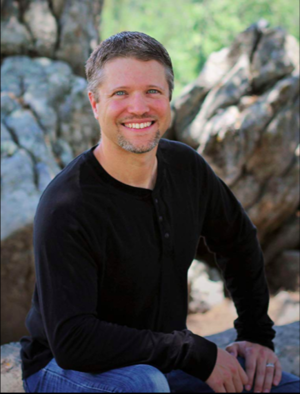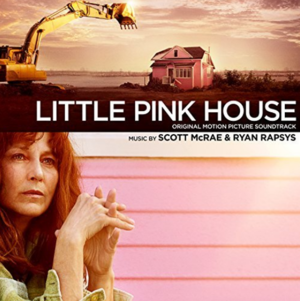Ryan Rapsys '15 didn’t put his headphones on at first. He needed to hear the composition fill the space. High in his loft recording studio, above the living area of his apartment in Santa Clarita, California, he let the sounds resonate. He was working on a series of scenes for the motion picture, Little Pink House, a 2017 biographical drama starring actor Catherine Keener, and the task was especially complex.

“The section started at a moment when Catherine’s partner in the film had an accident,” Ryan says. The viewer sees a montage of the accident, then the couple’s journey through a long rehabilitation, and finally their wedding.
Ryan matched music to feelings. “The piece was quite complicated… it began at the suffering during the disaster, through the complications of recovery, and eventually to joy.” He faded one sound seamlessly into the next.
“I started with electronics for the accident scene. I used a guitarist and dobro textures. Next, I added droning sounds to create tension. There's a moment when Catherine’s character climbs into bed with her partner to read him a serious letter and at that point, I used electric guitar effects to create a dark feeling.”
The composition for the montage took advanced preparation. “I thought a string quartet would be perfect for the final part, where the couple falls deeper in love and gets married,” he says.
Ryan wrote the music for two violins, a viola, and a cello and had the musicians play the piece three times. He mixed all the recordings together. “With four instruments playing three layers, I was able to create the sound of a 12-piece orchestra.”
For an entire day, going frame by frame, Ryan matched human emotion with sound and his work created one of the most powerful scenes in the film.
From Minnesota to California
Ryan grew up in Pike Lake, Minn., about 12 miles from Duluth. He played the trombone all through high school but his fascination with composing actually started with film. “I sat down with my dad and my brother, Robin, and we watched one movie after the next,” he said.
Years of film viewing taught him to look for more than the plot and characters; he paid attention to the score. By the time he arrived at UMD, he had created his first recording studio in his room. He’d write out music with a pencil and sheets of staff paper and then record it by using a collection of keyboards and musical instruments.

The UMD music program put Ryan together with Justin Rubin, professor of music and chair of the composition and theory program. “If I hadn’t met Justin Rubin, I wouldn’t be here,” Ryan says. “He opened my mind. I took a deep dive into film and music. I really enjoyed listening to different instruments, different sounds. He introduced me to so many composers, I learned about a whole new sonic world.”
By the time Ryan graduated in 2004, he had taught himself techniques in electronic sound engineering, producing, sequencing, mixing and mastering. He worked with photographer Craig Blacklock on Minnesota North Shore, a book and documentary DVD. Under Justin Rubin’s guidance and with inspiration from composer, Brian Eno, Ryan created the score for the documentary. “It was a unique bold score,” he says.
Ryan's life in Minnesota included composing scores for short videos and recording a music CD. He also married his wife, Christine. And then they were off to the Los Angeles area.
The California Dream
The Westwood loft was the site of his first California studio, and after that came the studio in Santa Clarita. Now Ryan has a studio in his house in Tehachapi, Calif., where he lives with Christine, his son Triston, and his dog, Lily.
Ryan continues to compose and arrange music for film, documentary, and commercial projects. IMDb, the definitive internet movie database, credits Ryan with 56 projects, two composing awards, and many nominations.
He does more than compositions for film. Ryan owns and operates the Resolution Music Collection, a production music library providing music tracks for licensing. "I've been involved in music licensing for a long time, including having my music used in 'Dateline,' NBC, 'The Today Show,' among many others," Ryan says. The database is accessed using search words. “I tag the music I create by emotion. I use words such as sad, happy, scary, and peaceful.” The user can refine their needs by genre, instrumentation, tempo, and more. “We have an extensive catalog, thousands of music clips, and we can provide companies what they need instantly.”
In addition to writing music scores for motion pictures and running a production music library, Ryan is doing a lot of work with music used for meditation. “That influence comes from Brian Eno as well,” he says. “Some of my ambient music is used in meditation videos as background sounds.”
Deep in the Scene
One of Ryan’s favorite moments was at the Santa Barbara Film Festival where he met singer-songwriter, David Crosby. Crosby was interested in the film because of its topic. It’s about a blue-collar woman who stands up to a corporation and small-town politicians. “David wrote a song especially for the movie,” Ryan says. The credits on the album, Little Pink House, list composers Ryan Rapsys and Scott McRae, alongside David Crosby.
Ryan mixes elements of classical, experimental, ambient, and electronic music and produces unique hybrid compositions. He has created a versatile composing style that works for different genres. The sensitivity he has for sounds that evoke specific and often subtle emotions is a tremendous asset. UMD is sure to hear more from Ryan in the coming years.
About the UMD Department of Music
